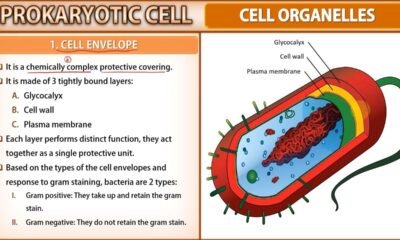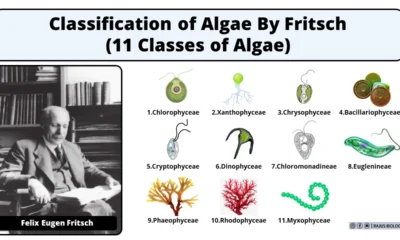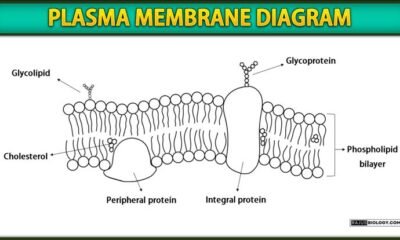Blog
Prokaryotic Cell: Definition, Characteristics and Structure | Free Biology Notes

In this article we will discuss about:- What is Prokaryotic Cell?, prokaryotic cell characteristics, prokaryotic cell structure and prokaryotic cell examples
What is Prokaryotic Cell?
- Prokaryotic cells are single celled microorganisms
- The term prokaryote is derived from Greek words, pro meaning before and karyon meaning nucleus
- First living organisms of the earth
- Prokaryotes include all bacteria
- All the reactions occur within the cytoplasm
- They can be free living or can be found within the gut of other organisms
Prokaryotic Cell Characteristics
- Do not have a true nucleus
- Membrane bound organelles absent
- Mitochondria, Golgi bodies, chloroplast, and lysosomes are absent
- Plasma membrane acts as the mitochondrial membrane carrying respiratory enzymes
- Cell wall is peptidoglycan
- Some may have flagella for movement
- Smaller & less complex than eukaryotes
Prokaryotic Cell Structure
Prokaryotic cell is not as complex as eukaryotic cells as they have primitive cell organelles. Generally, most prokaryotic cells have the following parts
Capsule
- Additional outer covering in some prokaryotic cells
- Protect the cell against foreign invaders.
- Capsule is made up of polysaccharides, that allows the cells to cling to various surfaces and preserves the moisture in the cell.
Cell wall
- Cell wall is a tough coring of prokaryotic cells present inside the capsule.
- Cell wall of most prokaryotes is made up of polymer of carbohydrates and lipids termed as peptidoglycan
- The cell wall provides shape to the cell while protecting the cell organelles present in the cytoplasm of the cell.
Plasma membrane
- Below the cell wall is a cell membrane that is made up of phospholipid.
- The phospholipid forms a bilayer consisting of lipid composed of glycerol attached to a hydrophobic phosphate head and two hydrophilic fatty acid tails.
- The plasma membrane in prokaryotic cells provides protection to the cell while allowing the transport of essential molecules in and out of the cell.
Cytoplasm
- Cytoplasm is the entire space of cells present inside of the cell membrane.
- It contains a gel-like cytosol and water-based solution that contains minerals and other ions essential for the cell.
- Besides, the cytoplasm also contains other cellular structures like the chromosomes and ribosomes.
Ribosomes
- All prokaryotic cells have 70S ribosomes. The 70S ribosomes are made up of two subunits, 30S, and 50S.
- 50S subunit contains 23S, and 5S rRNA and the 30S subunit contains 16S rRNA.
- The ribosome is the most commonly observed internal structure in prokaryotic cells.
- The ribosome is responsible for the formation of proteins
Nucleoid region
- The nucleoid region contains a single circular chromosome and small rings of extrachromosomal DNA called plasmids.
- The single circular chromosome is present as a single copy of genetic material in contrast to the two copies of DNA in eukaryotes.
- The prokaryotic genomes are also smaller in size than the eukaryotic genomes.
- The plasmids, in turn, are copied independently copied outside of the chromosomes. These plasmids might carry some non-essential genes.
Appendages
- Many prokaryotic cells have cell appendages that protrude out from the cell surface as flagella, pili, and fimbriae.
- Flagella are the most common appendages in many prokaryotic cells. These are tail-like structures that assist the cell in moving around.
- Fimbriae are thin filamentous structures that are used to stick the cells to various surfaces.
- Pilli, in turn, are longer filaments that have different roles in different cells. One example of this is the sex pilli that holds two cells together as they transfer the DNA molecules by the process of conjugation.
Prokaryotic Cell Examples
Bacterial cells
- Bacteria are the single-celled organisms that are found in all ecosystems throughout the world.
- Examples of bacterial cells are E. coli, Streptomyces spp, Pseudomonas spp, etc.
Archaeal cell (Archaea)
- Archaeal cells are similar to bacterial cells as they too are primitive unicellular organisms.
- Archaeal cells are mostly found in extreme environments like hot springs, oceans, and marshlands.
- Examples of archaeal cells are Halobacterium spp, Thermoplasma spp, Sulfolobus spp, etc.
Download PDF Study Material

 Blog7 months ago
Blog7 months ago[PPT] Human Reproduction Class 12 Notes
- Blog7 months ago
Contribution of Indian Phycologists (4 Famous Algologist)
- Blog7 months ago
PG TRB Botany Study Material PDF Free Download

 Blog7 months ago
Blog7 months agoCell The Unit of Life Complete Notes | Class 11 & NEET Free Notes

 Blog7 months ago
Blog7 months ago[PPT] The living world Class 11 Notes

 Blog7 months ago
Blog7 months agoClassification of Algae By Fritsch (11 Classes of Algae)

 Blog7 months ago
Blog7 months agoJulus General Characteristics | Free Biology Notes

 Blog7 months ago
Blog7 months agoPlasma Membrane Structure and Functions | Free Biology Notes














